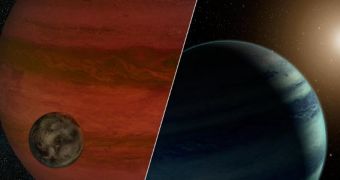A team of astronomers with the Microlensing Observations in Astrophysics (MOA) and the Probing Lensing Anomalies NETwork (PLANET) programs, which are jointly operated by the United States, New Zealand, and Japan, announce the discovery of a new and mysterious celestial object that may be either an extrasolar moon or a faint star surrounded by an exoplanet.
For this study, the group used telescopes located on the ground in Tasmania and New Zealand to investigate chance alignments between stars, via a technique called gravitational microlensing. This enabled them to discover an object as small and as dim as an exomoon. Such celestial bodies have never been identified directly to date, and this research may very well be the first to do so.
Interestingly, astronomers will not be able to see such a chance encounter between the same stars ever again. This means that the new study, and others that will soon follow, will remain unique for all eternity. As such, it is very important for experts to derive the maximum amount of knowledge from each such research and to derive general rules about how these investigations should be conducted.
“We won't have a chance to observe the exomoon candidate again. But we can expect more unexpected finds like this,” explains professor David Bennett from the University of Notre Dame in Indiana. He was also the lead author of a new paper detailing the findings, which was published in the latest issue of the esteemed Astrophysical Journal.
The reason why replicating this study will be impossible is that gravitational microlensing relies on small distortions in light emissions to see distant stars. For example, star A is located very far away from Earth, but star B happens to pass in between us and our target. The gravitational pull exerted by star B on its surroundings deforms the light emitted by star A, in effect acting like a magnifying lens.
This phenomenon is constantly used in astronomy, particularly to observe very distant galaxies and clusters whose light passes through and around other massive galaxies or clusters located closer to Earth. In microlensing, the chance alignments usually last less than a month. During such an interval, the research group noticed an unusual object that could be one of two things.
The first scenario is that the object is a planet around 18 times the mass of Earth, orbiting a star smaller and dimmer than the Sun. The second scenario is that we are looking at an exoplanet around two times more massive than Jupiter, which features a relatively large exomoon in its orbit. Unfortunately, figuring out which scenario is correct is impossible.
“One possibility is for the lensing system to be a planet and its moon, which if true, would be a spectacular discovery of a totally new type of system. The researchers' models point to the moon solution, but if you simply look at what scenario is more likely in nature, the star solution wins,” says investigator Wes Traub.
The expert holds an appointment as the chief scientist with the NASA Exoplanet Exploration Program office at the agency's Jet Propulsion Laboratory (JPL) in Pasadena, California; he was not involved in the new research.

 14 DAY TRIAL //
14 DAY TRIAL //